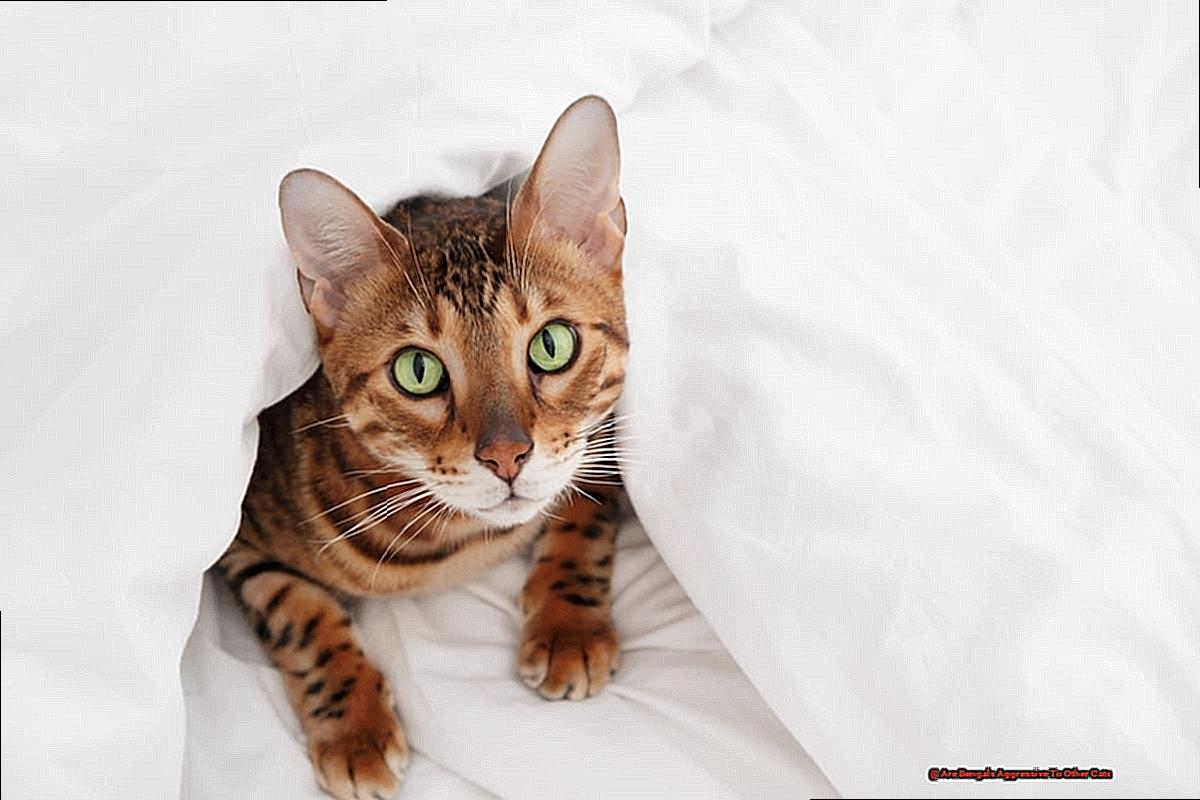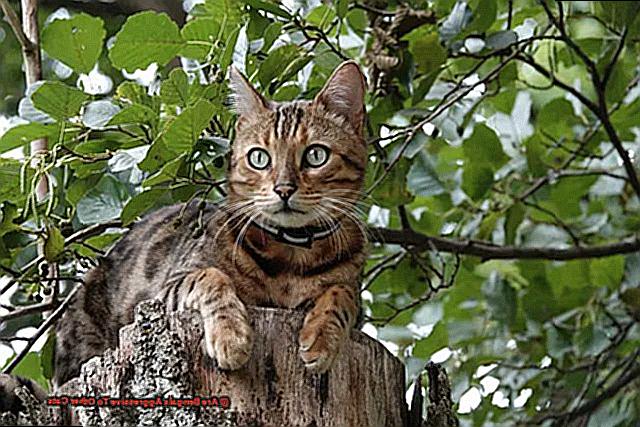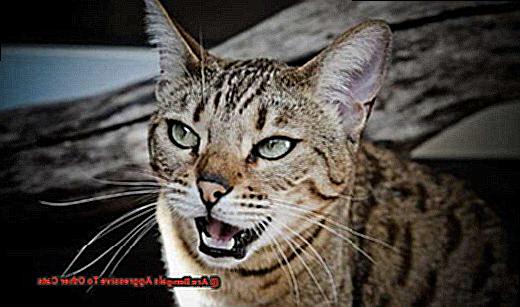Bengal cats are a unique breed, known for their stunning coat patterns and energetic personalities.
But there’s one aspect of their behavior that often raises questions – their tendency to be aggressive towards other cats. As a fellow cat lover and Bengal owner, I’ve experienced firsthand the challenges of managing this aggressive behavior.
So why do Bengals have such a feisty streak when it comes to other felines? In this post, we’ll delve into the fascinating world of Bengal cat behavior and uncover the reasons behind their aggression towards other cats.
So grab your favorite drink and let’s explore this intriguing topic together.

Are Bengals Aggressive To Other Cats?
Contents
Bengal cats are often admired for their unique and exotic appearance. With their striking coat patterns and energetic personalities, they are a popular breed among cat owners. However, there is a common misconception that Bengal cats are naturally aggressive towards other cats due to their wild ancestry. As a certified cat expert, I’m here to set the record straight and explore the various factors that can influence a Bengal’s behavior towards other felines.
Genetics vs. Individual Personality
First and foremost, it’s important to understand that a cat’s breed does not solely determine its behavior. While genetics may play a role in certain traits, each individual cat has its own unique personality and temperament, just like humans. This means that not all Bengal cats will display the same behaviors towards other cats.
High Energy Level and Hunting Instincts
One of the reasons why Bengal cats may have a reputation for being aggressive towards other cats is their high energy level and strong hunting instincts. These traits are inherited from their wild ancestors and can manifest in playfulness and roughhousing with other cats. However, it’s important to note that this behavior is not necessarily aggressive, but rather a natural expression of their instincts.
Socialization and Environment
The key to a well-behaved Bengal cat lies in proper socialization from a young age. If a Bengal is raised in a multi-cat household, it is more likely to develop positive relationships with other cats compared to one that has been isolated or not exposed to other animals. Additionally, the environment in which a Bengal is raised can also impact its behavior towards other cats. A well-socialized Bengal in a suitable environment is more likely to coexist peacefully with other cats.
Territorial Behaviors
As mentioned earlier, Bengals have strong territorial instincts due to their wild ancestry. This means they may exhibit aggressive behaviors towards other cats that they perceive as a threat to their territory. However, with proper training and management, this behavior can be minimized.
Mental Stimulation
Bengal cats are highly intelligent and require mental stimulation to prevent boredom. If they do not receive enough mental stimulation, they may exhibit aggressive behaviors towards other cats as a form of entertainment. Providing them with interactive toys and engaging activities can help prevent this.
The Misconception of Aggression
Many people believe that the wild ancestry of Bengals makes them inherently aggressive towards other felines. However, this is far from the truth. Let’s explore the role of various factors in shaping a Bengal’s behavior towards other cats.
First and foremost, it’s important to understand that aggression is a learned behavior and can be influenced by various factors. This means that while Bengals may have wild ancestry, their behavior towards other cats is not predetermined. Factors such as socialization, training, and environmental stimulation play key roles in how they interact with other felines.
Socialization, or the process of exposing a cat to different people, animals, and environments, is crucial in shaping their behavior towards others. If introduced to other cats at a young age and in a positive manner, Bengals can form strong bonds and even become best friends with them. On the other hand, if not properly socialized, Bengals may display territorial behavior and aggression towards other cats.
It’s also important to note that aggression in Bengals is not a breed-specific trait. Just like with any other cat breed, individual circumstances such as past experiences and environment can greatly influence their behavior. As highly intelligent animals, Bengals are also sensitive to the emotions of their owners. If they sense any tension or negative emotions from their owners towards other cats, it may contribute to their perceived aggression.
Another factor that can affect a Bengal’s behavior towards other cats is proper stimulation. These cats are known for their energetic and playful nature, so it’s important for owners to provide enough physical and mental stimulation to prevent any potential frustration or aggression.
Moreover, proper training techniques and positive reinforcement can also help prevent or manage any aggressive tendencies in Bengals towards other cats. By using positive reinforcement methods such as treats and praise, owners can teach their Bengals appropriate behaviors when interacting with other felines.

Factors that Influence a Bengal’s Behavior Towards Other Cats
First and foremost, let’s address the elephant in the room – genetics. Bengals are a hybrid breed, with their wild ancestor being the Asian leopard cat. This wild heritage can make them more territorial and prone to aggressive behavior towards other cats. However, this does not mean that all Bengals will exhibit this behavior. It is important to note that each cat is an individual with their own unique personality and experiences.
Another crucial factor in shaping a Bengal’s behavior towards other cats is socialization. Just like human children, cats also need proper socialization skills to interact positively with others. If a Bengal is not exposed to other cats at an early age, they may develop aggression towards them due to lack of experience and social skills. So, if you have a Bengal kitten, make sure to introduce them to other felines in a controlled and positive environment.
The environment in which a Bengal grows up also plays a significant role in their behavior towards other cats. If they are raised in a calm and peaceful household, they are less likely to exhibit aggressive behavior towards other cats. On the other hand, if they are constantly exposed to loud noises or stressful situations, it can make them more prone to aggression.
Past experiences can also shape a Bengal’s behavior towards other cats. If they have had negative encounters with other felines in the past, it can lead to fear or aggression towards them in the future. As owners, it is essential for us to recognize these triggers and address them accordingly.
So, what can you do to prevent or manage your Bengal’s aggression towards other cats? Proper socialization from a young age, providing a peaceful environment, and avoiding negative interactions with other felines are all crucial steps. Additionally, seeking the help of an animal behaviorist or trainer can also be beneficial in managing aggression. They can provide guidance on proper socialization techniques and behavior modification exercises to help improve your Bengal’s behavior towards other cats.
The Importance of Socialization in Curbing Aggression
Bengal cats are known for their wild and playful nature, making them a popular choice for many cat owners. However, without proper socialization, their high energy levels and natural instincts can sometimes lead to aggressive behavior towards other cats.
As an expert on the topic, I want to emphasize the crucial role that socialization plays in shaping a Bengal’s behavior and how it can prevent potential conflicts with other feline companions.
Socialization is the process of exposing a cat to different people, animals, and environments from a young age in order to develop their social skills. It is a critical period of learning and forming behaviors for kittens between 3-9 weeks old. During this time, they are highly impressionable and can easily adapt to new situations and experiences.
The Benefits of Socialization for Bengals
Proper socialization can help Bengals learn to coexist peacefully with other cats. It teaches them how to communicate effectively and prevent aggressive tendencies towards other felines. Additionally, socialization can also prevent other behavioral issues such as excessive scratching or spraying.
Continuing Socialization throughout a Bengal’s Life
While early socialization is crucial, it is equally important to continue socializing Bengals throughout their lives. Kittens who were not properly socialized during their critical period may develop fear or aggression towards other cats later on. By regularly exposing them to different environments, people, and animals, Bengals can maintain positive interactions with other cats.
Tips for Effective Socialization
Introduce Bengals to other cats gradually and under supervision to prevent any negative interactions. Use positive reinforcement techniques such as treats, toys, and praise to associate good behavior with pleasant experiences. This will help them learn that interacting with other cats can be enjoyable and rewarding.
Expose Bengals to different environments and stimuli to prevent them from becoming territorial or stressed in new situations. This can include taking them on walks, introducing them to new toys, or even bringing them to a friend’s house with other cats.
Seeking Professional Help
In some cases, a Bengal who has already developed aggressive tendencies towards other cats may require professional help to properly socialize. A behaviorist or trainer can provide guidance and create a personalized plan to help your Bengal overcome their aggressive behavior.
Prey Drive and Territorial Nature in Bengals
For many cat owners, the thought of aggression between cats in a household can be a cause for concern. And when it comes to Bengal cats, their strong prey drive and territorial nature can make this issue even more daunting. But fear not, as with proper socialization and training, you can prevent aggression in your Bengal towards other cats.
Inherited from their wild ancestors, the Asian Leopard Cat, Bengals have a strong prey drive that is ingrained in their DNA. This instinct can manifest in aggressive behavior towards other cats, seeing them as potential prey. Additionally, their territorial nature can also lead to aggression towards other felines who enter their perceived territory.
However, it is important to note that not all Bengals exhibit aggressive behavior towards other cats. It can vary from cat to cat and may also depend on their environment and socialization. That’s why it is crucial to properly socialize your Bengal from a young age and continue this process throughout their lives.
Proper socialization involves exposing your Bengal to different people, environments, and animals in a controlled and positive manner. This will help them become more comfortable and less reactive towards other cats.
In addition to socialization, training is also essential in managing your Bengal’s aggressive tendencies towards other cats. Use positive reinforcement techniques such as treats and praise to reward good behavior and redirect any aggressive behavior towards other cats.
Another factor that can contribute to aggression in Bengal cats is competition for resources such as food, toys, and attention. To prevent conflicts, make sure you provide enough resources for each cat in a multi-cat household.
Introducing new cats into a household with a Bengal can also be a delicate process. Take it slow and allow for gradual integration between the cats. This will give them time to get used to each other’s scents and help minimize potential aggression.
As an owner, it is also important to understand your Bengal’s body language and communication. Signs of aggression such as growling, hissing, and raised fur should be addressed immediately to prevent any further escalation.
The Role of Mental Stimulation in Preventing Aggressive Behaviors
Bengal cats are known for their wild and energetic nature. As owners, it is our responsibility to provide them with the proper care and stimulation they need to thrive. One important aspect of care that is often overlooked is mental stimulation. In this section, we will explore the role of mental stimulation in preventing aggressive behaviors in Bengals.
Understanding the Importance of Mental Stimulation
Bengals are highly intelligent and active cats. When they don’t receive enough mental stimulation, they can become bored and frustrated. This can lead to destructive behaviors and aggression towards other cats. Providing mental stimulation not only keeps your Bengal entertained, but it also helps them release any pent-up energy in a positive way.
Enrichment Activities for Bengals
There are many ways to keep your Bengal mentally stimulated. Here are some ideas that you can try:
- Puzzle toys: These toys require your Bengal to use their problem-solving skills to get a treat or toy out of the puzzle. It not only keeps them mentally stimulated but also provides a fun and rewarding activity.
- Interactive playtime: Bengals love to play. Engaging in interactive playtime with your cat using toys like wand teasers or laser pointers not only provides mental stimulation but also strengthens the bond between you and your Bengal.
- Training sessions: Many people believe that cats cannot be trained, but this is not true. Bengals are highly trainable and enjoy learning new tricks. Teaching them basic commands or fun tricks can keep their minds engaged and prevent boredom.
Adjusting Mental Stimulation According to Your Bengal’s Needs
It is important to note that every Bengal is different and may have varying levels of need for mental stimulation. Some may require more enrichment activities than others, while some may prefer certain activities over others. It is crucial for owners to observe their cat’s behavior and adjust the level of mental stimulation accordingly.
Introducing Enrichment Activities Gradually
When introducing new enrichment activities, it is important to do so gradually and in a positive manner. This helps prevent overwhelming your Bengal or causing any negative reactions. Start with short sessions and slowly increase the duration and difficulty level as your Bengal becomes more comfortable and confident.
Managing Potential Aggression Towards Other Cats
These stunning creatures are known for their intelligence, athleticism, and of course, their wild ancestry. But with that wild ancestry comes a strong prey drive that can sometimes manifest as aggression towards other cats. As loving pet owners, it is our responsibility to understand and manage this behavior to ensure a peaceful environment for all our feline companions.
So, let’s dive into some expert tips for managing potential aggression towards other cats.
Socialization is Key
One of the best ways to prevent aggression towards other cats is through proper socialization. It is essential to introduce your Bengal to other cats at a young age, preferably between 3 to 9 weeks old. This allows them to learn appropriate social behaviors and reduces the chances of aggression towards other cats in the future.
Establish Yourself as the Leader
Bengals are highly intelligent and require a strong leader to guide their behavior. As their owner, it is crucial to establish yourself as the leader of the pack. Set clear boundaries and consistently reinforce them to prevent any dominant behavior towards other cats.
Resources for All
Aggression can arise when cats feel like they have to compete for resources such as food, water, toys, or even attention from their owners. Make sure each cat has their own designated resources and enough of them to reduce potential conflicts.
Provide a Safe Space
In cases where aggression towards other cats cannot be completely managed, it is crucial to have a safe space for each cat. This can be a separate room or a high perch that only one cat can access. It provides a retreat for the targeted cat and prevents any physical altercations.
Seek Professional Help
If the aggression towards other cats persists, it may be necessary to seek professional help from a certified animal behaviorist. They can assess the situation and provide tailored advice on how to manage the behavior effectively.
Conclusion
In conclusion, Bengal cats are an extraordinary breed that captivates us with their striking appearance and lively personalities. However, their behavior towards other cats has been a topic of debate and concern among cat lovers. As a fellow Bengal owner, I have personally experienced the challenges of managing this behavior.
Throughout this article, we have delved into the various factors that can influence a Bengal’s attitude towards other felines. We have discovered that genetics, individual temperament, high energy levels and hunting instincts, socialization, environment, and territorial behaviors all contribute to shaping a Bengal’s behavior towards other cats.
It is crucial to understand that aggression is not an inherent trait in Bengals and can be influenced by multiple factors. Proper socialization from an early age, providing mental stimulation, understanding body language and communication, and seeking professional help if necessary are all essential in managing potential aggression towards other cats.
As responsible pet owners, it is our responsibility to provide our Bengals with the care and attention they need. By comprehending their unique needs and behaviors, we can create a harmonious environment for all our feline companions.






